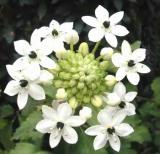Ornithogalum (Ever Pregnant or Pregnant Onion)

Ornithogalum (Ornithogalum caudatum Ornithogalum thyrsoidesOrnithogalum longebracteatum) belong to the lily family. It is bulbous plant and has its origin is Europe and South Africa.. All the ornithogalum varieties flower with star-like blooms, some clustering along the top half of an upright stem and some creating umbrella or candelabra forms.
In the common language these plants are called the Pregnant Onion because it makes little "babies" on the side of its bulb which can then be potted and grown into entire pregnant onion plants. It is grown as a houseplant, or outdoors as an ornamental plant in warmer climates. It is a very hardy plant and can withstand all types of climates. It likes a lot of water.
Growing information: The Pregnant Onion is a very easy plant to grow. All it needs is an occasional watering, because it is a water succulent plant. The plants may be brought inside during winter. These plants are hardy and can withstand low temperatures 25°F (-4°C), but they can perish if they are in the cold for too long. This plant is resilient against pests and disease. Scales is the only known disease that can affect the Pregnant Onion.
Flowers: It has tiny white, sometimes yellow, flowers that have a green stripe down the center. They flower on a stalk which grows up from the center of the bulb. It is said that these flowers have a fragrance but it is either to mild or we humans cannot get its aroma. Don't expect your plant to flower right away unless it is an older plant. From my experience, I have found that with proper care and patients, it will bloom in the second or third year.
Sunlight and Watering: Even though the Pregnant Onion is a resilient plant; it is a plant nonetheless and can get dried up if left in the direct sun without water for long periods of time. Pregnant Onions seem to do best in an area that has some shade but exposure to the sun. A north or east facing window or side of a building is the best location. They would receive the morning sun and into the afternoon and are sheltered from the direct sunlight. They are a water succulent plant; they do not need watering everyday, so do not over water them. They store up water and ration it off as time goes by. This is a characteristic feature of plants that live in arid conditions, like cactus. They have, under the outer fleshy skin, a water-storing tissue that acts as water reservoirs for the plant. All that you have to do is to water them every three to four days. Some people water them when the skin becomes soft and wrinkly. After watering, the bulb swells up smooth and green.
Soil: In most cases, if you are starting out with new bulbs, it would be a good idea to plant them in potting soil. Potting soil is rich in nutrients that your Pregnant Onion will need. If your plant comes already with soil use that soil since it is aclimatised to it. If you are planting in potting soil, you might want to mix it with a little compost manure and a small amount of sharp sand. The potting soil and manure is for supply nutrients and the sand is used to help drain the excess water out of the bottom of the pot, because the bulb stores the water and can become waterlogged. If you plan to plant these in the garden then do the same as you would do in a pot; add manure and sand? When you do plant outside, make sure that your bulb is in a well protected area. The more ideal the environment is for a young bulb, the longer it will live. The major difference comes with the change of the seasons. You'll need to mulch the ground in cold weather. Remember, this plant is native to South Africa and isn't best adapted to the cold.
Transplanting and Pruning: You can prune the leaves if you desire. The leaves do have a tendency to die off after time. This is because the bulb is growing and the old leaves are not large enough to cover the ever enlarging area. So, to help the plant grow larger, it will loose the outer leaves. Once the leaf dies off, the outer layer of skin will dry up. This outer skin will peel off but if you would like a neater looking plant, you can carefully peel off this dead skin. Your other leaves might develop brown tips on them as well. This is in order and all you need to do is trim them back to the green.
Propagation: When these bulbs have been growing for a year or two small baby bulbs commence to grow on the sides of the mother bulb. Watching new bulb-lets pop out of the mother is a wonderful experience. After the bulb matures enough, depending on the harshness of its environmental conditions, your Pregnant Onion will be ready to begin making babies. Some more information regarding Ornitogaulm bulbs is given in the tables below: 
